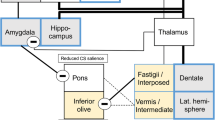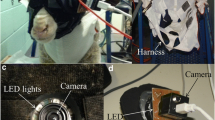Abstract
Context dependency of extinction is well known and has extensively been studied in fear conditioning, but has rarely been assessed in eyeblink conditioning. One way to demonstrate context dependency of extinction is the renewal effect. ABA paradigms are most commonly used to show the renewal effect of extinguished learned fear: if acquisition takes place in context A, and extinction takes place in context B (extinction phase), learned responses will recover in subsequent extinction trials presented in context A (renewal phase). The renewal effect of the visual threat eyeblink response (VTER), a conditioned eyeblink response, which is naturally acquired in early infancy, was examined in a total of 48 young and healthy participants with two experiments using an ABA paradigm. Twenty paired trials were performed in context A (baseline trials), followed by 50 extinction trials in context B (extinction phase) and 50 extinction trials in context A (renewal phase). In 24 participants, contexts A and B were two different rooms, and in the other 24 participants, two different background colors (orange and blue) and noises were used. To rule out spontaneous recovery, an AAA design was used for comparison. There were significant effects of extinction in both experiments. No significant renewal effects were observed. In experiment 2, however, extinction was significantly less using orange background during extinction compared to the blue background. The present findings suggest that extinction of conditioned eyeblinks depends on the physical context. Findings add to the animal literature that context can play a role in the acquisition of classically conditioned eyeblink responses. Future studies, however, need to be performed to confirm the present findings. Lack of renewal effect may be explained by the highly overlearned character of the VTER.



Similar content being viewed by others
References
Alvarez RP, Johnson L, Grillon C (2007) Contextual-specificity of short-delay extinction in humans: renewal of fear-potentiated startle in a virtual environment. Learn Mem 14:247–253
Ball W, Tronick E (1971) Infant responses to impending collision: optical and real. Science 171:818–820
Bouton ME (2002) Context, ambiguity, and unlearning: sources of relapse after behavioral extinction. Biol Psychiatry 52:976–986
Bouton ME, King DA (1983) Contextual control of the extinction of conditioned fear: tests for the associative value of the context. J Exp Psychol Anim Behav Process 9:248–265
Bracha V, Zhao L, Wunderlich DA, Morrissy SJ, Bloedel JR (1997) Patients with cerebellar lesions cannot acquire but are able to retain conditioned eyeblink reflexes. Brain 120:1401–1413
Byrne A (2003) Color and similarity, philosophy and phenomenological research. Philos Phenomenol Res 66:641–665
Effting M, Kindt M (2007) Contextual control of human fear associations in a renewal paradigm. Behav Res Ther 45:2002–2018
Elliot AJ, Maier MA, Moller AC, Friedman R, Meinhardt J (2007) Color and psychological functioning: the effect of red on performance attainment. J Exp Psychol Gen 136:154–168
Elliot AJ, Maier MA, Binser MJ, Friedman R, Pekrun R (2009) The effect of red on avoidance behavior in achievement contexts. Personal Soc Psychol Bull 35:365–375
Gerwig M, Dimitrova A, Kolb FP, Maschke M, Brol B, Kunnel A, Böring D, Thilmann AF, Forsting M, Diener HC, Timmann D (2003) Comparison of eyeblink conditioning in patients with superior and posterior inferior cerebellar lesions. Brain 126:71–94
Gerwig M, Guberina H, Esser AC, Siebler M, Schoch B, Frings M, Kolb FP, Aurich V, Beck A, Forsting M, Timmann D (2010) Evaluation of multiple-session delay eyeblink conditioning comparing patients with focal cerebellar lesions and cerebellar degeneration. Behav Brain Res 212:143–151
Grillon C, Alvarez RP, Johnson L, Chavis C (2008) Contextual specificity of extinction of delay but not trace eyeblink conditioning in humans. Learn Mem 15:387–389
Hardiman MJ, Yeo CH (1992) The effect of kainic acid lesions of the cerebellar cortex on the conditioned nictitating membrane response in the rabbit. Eur J Neurosci 4:966–980
Harris JA, Jones ML, Bailey GK, Westbrook RF (2000) Contextual control over conditioned responding in an extinction paradigm. J Exp Psychol Anim Behav Process 26:174–185
Havermans RC, Keuker J, Lataster T, Jansen A (2005) Contextual control of extinguished conditioned performance in humans. Learn Motiv 36:1–19
Kehoe EJ, Weidemann G, Dartnall S (2004) Apparatus exposure produces profound declines in conditioned nictitating-membrane responses to discrete conditioned stimuli by the rabbit (Oryctolagus cuniculus). J Exp Psychol Anim Behav Process 30:259–270
LaBar KS, Phelps EA (2005) Reinstatement of conditioned fear in humans is context dependent and impaired in amnesia. Behav Neurosci 119:677–686
Lissek S, Glaubitz B, Uengoer M, Tegenthoff M (2013) Hippocampal activation during extinction learning predicts occurrence of the renewal effect in extinction recall. Neuroimage 81:131–143
Liu GT, Ronthal M (1992) Reflex blink to visual threat. J Clin Neuroophthalmol 12:47–56
Mac Keith RC (1969) The eye and vision in the newborn infant. In: Gardiner P, Mac Keith RC, Smith VH (eds) Aspects of developmental and pediatric ophthalmology. Spastics International Medical Publications in association with Heinemann, London, pp 9–14
Maren S, Phan KL, Liberzon I (2013) The contextual brain: implications for fear conditioning, extinction and psychopathology. Nat Rev Neurosci 14:417–428
McCormick DA, Thompson RF (1984) Cerebellum: essential involvement in the classically conditioned eyelid response. Science 20:296–299
Milad MR, Quirk GJ (2012) Fear extinction as a model for translational neuroscience: 10 years of progress. Annu Rev Psychol 63:129–151
Milad MR, Orr SP, Pitman RK, Rauch SL (2005) Context modulation of memory for fear extinction in humans. Psychophysiology 42:456–464
Moustafa AA, Gilbertson MW, Orr SP, Herzallah MM, Servatius RJ, Myers CE (2013) A model of amygdala-hippocampal-prefrontal interaction in fear conditioning and extinction in animals. Brain Cognit 81:29–43
Náñez JE Sr (1988) Perception of impending collision in 3-to 6-week-old human infants. Infant Behav Dev 11:447–463
Neumann DL (2006) The effects of physical context changes and multiple extinction contexts on two forms of renewal in a conditioned suppression task with humans. Learn Motiv 37:149–175
Neumann DL, Kitlertsirivatana E (2010) Exposure to a novel context after extinction causes a renewal of extinguished conditioned responses: implications for the treatment of fear. Behav Res Ther 48:565–570
Ohman A, Bohlin G (1973) The relationship between spontaneous and stimulus-correlated electrodermal responses in simple and discriminative conditioning paradigms. Psychophysiology 10(6):589–600
Ohman A, Eriksson A, Olofsson C (1975) One-trial learning and superior resistance to extinction of autonomic responses conditioned to potentially phobic stimuli. J Comp Physiol Psychol 88(2):619–627
Orsini CA, Kim JH, Knapska E, Maren S (2011) Hippocampal and prefrontal projections to the basal amygdala mediate contextual regulation of fear after extinction. J Neurosci 31:17269–17277
Pape HC, Parè D (2010) Plastic synaptic networks of the amygdala for the acquisition, expression, and extinction of conditioned fear. Physiol Rev 90:419–463
Pavlov I (1927) Conditioned responses. Anrep GV translator. Oxford University Press, London
Penick S, Solomon PR (1991) Hippocampus, context, and conditioning. Behav Neurosci 105:611–617
Poulos AM, Pakaprot N, Mahdi B, Kehoe EJ, Thompson RF (2006) Decremental effects of context exposure following delay eyeblink conditioning in rabbits. Behav Neurosci 120:730–734
Rescorla RA (2008) Within-subject renewal in sign tracking. Q J Exp Psychol (Hove) 61:1793–1802
Robleto K, Poulos AM, Thompson RF (2004) Brain mechanisms of extinction of the classically conditioned eyeblink response. Learn Mem 11:517–524
Thieme A, Thürling M, Galuba J, Burciu RG, Göricke S, Beck A, Aurich V, Wondzinski E, Siebler M, Gerwig M, Bracha V, Timmann D (2013) Storage of a naturally acquired conditioned response is impaired in patients with cerebellar degeneration. Brain 136:2063–2076
Thürling M, Galuba J, Thieme A, Burciu RG, Göricke S, Beck A, Wondzinski E, Siebler M, Gerwig M, Bracha V, Timmann D (2014) Age effects in storage and extinction of a naturally acquired conditioned eyeblink response. Neurobiol Learn Mem 109:104–112
Todd TP, Vurbic D, Bouton ME (2014) Mechanisms of renewal after the extinction of discriminated operant behavior. J Exp Psychol Anim Learn Cognit 40:355–368
Vansteenwegen D, Hermans D, Vervliet B, Francken G, Beckers T, Baeyens F, Eelen P (2005) Return of fear in a human differential conditioning paradigm caused by a return to the original acquisition context. Behav Res Ther 43:323–336
Acknowledgments
The study was supported by DFG Research Unit FOR 1581 (Extinction Learning: Neural Mechanisms, Behavioral Manifestations and Clinical Implications).
Author information
Authors and Affiliations
Corresponding author
Ethics declarations
Conflict of interest
The authors declare that they have no conflict of interest.
Ethical approval
All procedures performed in studies involving human participants were in accordance with the ethical standards of the institutional and/or national research committee and with the 1964 Helsinki declaration and its later amendments or comparable ethical standards.
Rights and permissions
About this article
Cite this article
Claassen, J., Mazilescu, L., Thieme, A. et al. Lack of renewal effect in extinction of naturally acquired conditioned eyeblink responses, but possible dependency on physical context. Exp Brain Res 234, 151–159 (2016). https://doi.org/10.1007/s00221-015-4450-2
Received:
Accepted:
Published:
Issue Date:
DOI: https://doi.org/10.1007/s00221-015-4450-2




